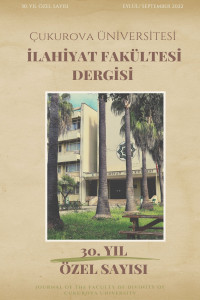Eş’arî’de Hadis ve Sünnet -el-İbâne Örneği-
İmam Eş’arî, Ehl-i Sünnet düşüncesinin Eş’arîyye ekolünün kurucusu olan ünlü bir kelâm âlimidir. Hicrî 260/873 yılında Basra’da doğmuş, 324/936’da Bağdat’ta vefat etmiştir. Onun itikâdî görüş ve düşüncelerinin ele alındığı en önemli eserlerinden biri el-İbâne adlı eseridir. Bu eser aynı zamanda Mutezile ve Kaderiye gibi bidat fırkalarına bir reddiye mahiyetindedir. Dolayısıyla Eş’arî’yi diğerlerinden ayıran düşünce ve yöntem bir ölçüde bu eserde ortaya konulmuştur. el-İbâne’de yoğun bir şekilde hadis kullanıldığı görülmektedir. Eş’arî, hadis, rivayet, haber ve sünnet terimlerini aynı anlamda kullanmıştır. Onun âhâd haberleri itikâdî konularda bir delil olarak kullanması dikkat çekicidir. O, hadisleri sünnet kavramıyla ilişkilendirmekte ve bu kavram temelinde onlara bir değer atfetmektedir. Ayrıca onun, hadisleri yorumlamada metnin zâhirine sıkı sıkıya bağlı kalmayı tercih ettiği de müşahede edilmektedir.
Hadith and Sunnah at al-Ash’ari -A Sample of al-Ibana
al-Ash’ari is one of the biggest scholar of Ahlus Sunnah Thought and he is founder of Ash’ariyye faction of Ahlus Sunnah School. Ash’ari was born in 260/873 at Basra and dead in 324/936 at Bağdad. Undoubtedly his most important work dealt with the ideas of belief and opinion by the work of al-Ibane. The work at the same time is the characteristics of a criticism to Bidat groups such as Mutazile and Kadariyya. Teherefore, this work has revealed a degree of Ash’ari distinguishers it is a piece of thought and method. Ash’ari uses the terms of hadith, al-Rivaye, al-haber in the same meaning in his work by al-Ibâne. Contrary to the general conclusion that the al-haber al-ahad could not be evidence in beliefs issues hadith is used as anevidence in his work. In addition, he interpreate hadiths to be bound by strict of the text, in other words, the literal interpretaiton of choice is observed.
